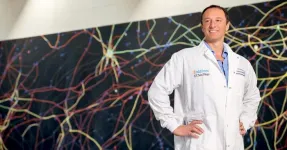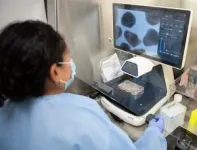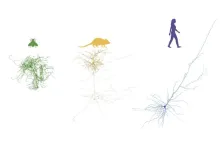(Press-News.org) Researchers worldwide can now create highly realistic brain cortical organoids — essentially miniature artificial brains with functioning neural networks — thanks to a proprietary protocol released this month by researchers at the University of California San Diego.
The new technique, published in Nature Protocols, paves the way for scientists to perform more advanced research regarding autism, schizophrenia and other neurological disorders in which the brain’s structure is usually typical, but electrical activity is altered. That’s according to Alysson Muotri, Ph.D., corresponding author and director of the UC San Diego Sanford Stem Cell Institute (SSCI) Integrated Space Stem Cell Orbital Research Center. The SSCI is directed by Dr. Catriona Jamieson, a leading physician-scientist in cancer stem cell biology whose research explores the fundamental question of how space alters cancer progression.
The newly detailed method allows for the creation of tiny replicas of the human brain so realistic that they rival “the complexity of the fetal brain’s neural network,” according to Muotri, who is also a professor in the UC San Diego School of Medicine’s Departments of Pediatrics and Cellular and Molecular Medicine. His brain replicas have already traveled to the International Space Station (ISS), where their activity was studied under conditions of microgravity.
Two other protocols for creating brain organoids are publicly accessible, but neither allow researchers to study the brain’s electrical activity. Muotri’s method, however, allows researchers to study neural networks created from the stem cells of patients with various neurodevelopmental conditions.
“You no longer need to create different regions and assemble them together,” said Muotri, adding that his protocol allows different brain areas — like the cortex and midbrain — “to co-develop, as naturally observed in human development.”
“I believe we will see many derivations of this protocol in the future for the study of different brain circuits,” he added.
Such “mini brains” can be used to test potentially therapeutic drugs and even gene therapies before patient use, as well as to screen for efficacy and side effects, according to Muotri.
A plan to do so is already in the works. Muotri and researchers at the Federal University of Amazonas in Manaus, Amazonas, Brazil, are teaming up to record and investigate Amazonian tribal remedies for Alzheimer’s disease — not on Earth-based mouse models, but on diseased human brain organoids in space.
A recent Humans in Space grant — awarded by Boryung, a leading health care investment company based in South Korea — will help fuel the research project, which spans multiple continents and habitats, from the depths of the Amazon rainforest to Muotri’s lab on the coast of California — and, eventually, to the International Space Station.
Other research possibilities for the brain organoids include disease modeling, understanding human consciousness and additional space-based experiments. In March, Muotri — in partnership with NASA — sent to space a number of brain organoids made from the stem cells of patients with Alzheimer’s disease and ALS (amyotrophic lateral sclerosis, also known as Lou Gehrig’s disease). The payload returned in May and results, which will eventually be published, are being reviewed.
Because microgravity mimics an accelerated version of Earth-based aging, Muotri should be able to witness the effects of several years of disease progression while studying the month-long mission’s payload, including potential changes in protein production, signaling pathways, oxidative stress and epigenetics.
“We’re hoping for novel findings — things researchers haven’t discovered before,” he said. “Nobody has sent such a model into space, until now.”
Co-authors of the study include Michael Q. Fitzgerald, Tiffany Chu, Francesca Puppo, Rebeca Blanch and Shankar Subramaniam, all of UC San Diego, and Miguel Chillón, of the Universitat Autònoma de Barcelona and the Institució Catalana de Recerca i Estudis Avançats, both in Barcelona, Spain. Blanch is also affiliated with the Universitat Autònoma de Barcelona.
This work was supported by the National Institutes of Health R01MH100175, R01NS105969, MH123828, R01NS123642, R01MH127077, R01ES033636, R21MH128827, R01AG078959, R01DA056908, R01HD107788, R01HG012351, R21HD109616, R01MH107367, California Institute for Regenerative Medicine (CIRM) DISC2-13515 and a grant from the Department of Defense W81XWH2110306.
About the Sanford Stem Cell Institute
The UC San Diego Sanford Stem Cell Institute (SSCI) is a global leader in regenerative medicine and a hub for stem cell science and innovation in space. SSCI aims to catalyze critical basic research discoveries, translational advances and clinical progress — terrestrially and in space — to develop and deliver novel therapeutics to patients.
# # #
END
UC San Diego develops first-in-kind protocol for creating ‘wired miniature brains’
The development paves the way for more advanced research regarding autism, schizophrenia and other neurological disorders
2024-06-10
ELSE PRESS RELEASES FROM THIS DATE:
Lone Star State: Tracking a low-mass star as it speeds across the Milky Way
2024-06-10
It may seem like the Sun is stationary while the planets in its orbit are moving, but the Sun is actually orbiting around the Milky Way galaxy at an impressive rate of about 220 kilometers per second — almost half a million miles per hour. As fast as that may seem, when a faint red star was discovered crossing the sky at a noticeably quick pace, scientists took notice.
Thanks to the efforts of a citizen science project called Backyard Worlds: Planet 9 and a team of astronomers from around the country, a rare hypervelocity ...
Researchers demonstrate the first chip-based 3D printer
2024-06-10
CAMBRIDGE, MA – Imagine a portable 3D printer you could hold in the palm of your hand. The tiny device could enable a user to rapidly create customized, low-cost objects on the go, like a fastener to repair a wobbly bicycle wheel or a component for a critical medical operation.
Researchers from MIT and the University of Texas at Austin took a major step toward making this idea a reality by demonstrating the first chip-based 3D printer. Their proof-of-concept device consists of a single, millimeter-scale photonic ...
Making remanufacturing profitable
2024-06-10
Returning end-of-life products to as-new condition is called remanufacturing and can be an essential element in a circular economy. But for more industrial companies to take an interest in it, remanufacturing needs to be economically viable. In a doctoral thesis from Linköping University, Johan Vogt Duberg has investigated how this can be accomplished.
“It’s possible to take advantage of increased environmental awareness to gain economic benefits. With remanufacturing, the costs of raw materials can be reduced, new customer groups found and ...
NSF awards additional $9.8 Million for Delta, DeltaAI
2024-06-10
The National Center for Supercomputing Applications was recently awarded $4.9 million of supplemental funding from the U.S. National Science Foundation (NSF) for Delta and an additional $4.9 million for DeltaAI to expand the potential capabilities of the soon-to-launch system by nearly 50 percent.
NCSA originally received nearly $25 million from NSF in 2023 to deploy and operate DeltaAI, an advanced computing and data resource that will be a companion system to Delta. DeltaAI will triple NCSA’s AI-focused computing capacity and ...
Breakthrough in creating cyclic peptide opens the way for new antibiotics
2024-06-10
A discovery made by scientists at King’s College London could speed up efforts to produce new antibiotics in the fight against antimicrobial resistance.
In a paper published in the Journal of the American Chemical Society, scientists from the Department of Chemistry share a new, rapid method for making cyclic peptides – an important class of antibiotic molecules. The approach takes minutes rather than the hours or days it normally takes, helping overcome a major challenge in antibiotic development.
Lead author Dr Sarah Barry, from the Department of Chemistry at King’s College London, ...
Unregulated sales of a toxic and hallucinogenic mushroom endanger public health
2024-06-10
Americans’ interest in a potentially harmful “magic mushroom” is soaring, with Google searches skyrocketing 114 percent from 2022 to 2023, according to a new study by researchers at the University of California San Diego Herbert Wertheim School of Public Health and Human Longevity Science. In a paper published in the American Journal of Preventive Medicine, the scientists suggest that the growing market for Amanita muscaria may be sparked in part by emerging clinical research supporting the safety and efficacy of psilocybin as a treatment ...
Alarming trends call for action to define the future role of food in nation’s health
2024-06-10
CHICAGO, June 10, 2024 — The cost of nutritious food and the lack of access to it are of significant concern to U.S. consumers. That’s according to a new national poll of public attitudes on food and nutrition conducted by Zogby Analytics on behalf of Research!America and the American Heart Association. Nearly 7 in 10 (68%) respondents recognize healthy eating habits as an important factor in improving a person’s chance for a long and healthy life. Yet more than half (53%) say the United ...
Case studies show how quasi-governmental organizations could strengthen climate adaptation governance
2024-06-10
The politicization of climate issues and the unsynchronized efforts of stakeholders are hindering the effectiveness of climate adaptation governance in the U.S. According to a new study(Link is external) published by Princeton researchers, the design characteristics of quasi-governmental organizations (QGOs) could provide insights on how to depoliticize climate information sources and foster multi-level stakeholder coordination.
Quasi-governmental organizations are entities that have a combination of public and private characteristics, utilizing both for-profit and not-for-profit ...
Brain’s structure hangs in ‘a delicate balance’
2024-06-10
When a magnet is heated up, it reaches a critical point where it loses magnetization. Called “criticality,” this point of high complexity is reached when a physical object is transitioning smoothly from one phase into the next.
Now, a new Northwestern University study has discovered that the brain’s structural features reside in the vicinity of a similar critical point — either at or close to a structural phase transition. Surprisingly, these results are consistent across brains from humans, mice and fruit flies, which suggests the finding might be universal.
Although the researchers don’t ...
Protein study could help researchers develop new antibiotics
2024-06-10
A bacterial enzyme called histidine kinase is a promising target for new classes of antibiotics. However, it has been difficult to develop drugs that target this enzyme, because it is a “hydrophobic” protein that loses its structure once removed from its normal location in the cell membrane.
Now, an MIT-led team has found a way to make the enzyme water-soluble, which could make it possible to rapidly screen potential drugs that might interfere with its functions.
The researchers created their new version ...
LAST 30 PRESS RELEASES:
Scientists trace microplastics in fertilizer from fields to the beach
The Lancet Obstetrics, Gynecology, & Women’s Health: Taking paracetamol during pregnancy does not increase risk of autism, ADHD or intellectual disabilities, confirms new gold-standard evidence review
Taking paracetamol during pregnancy does not increase risk of autism, ADHD or intellectual disabilities
Harm reduction vending machines in New York State expand access to overdose treatment and drug test strips, UB studies confirm
University of Phoenix releases white paper on Credit for Prior Learning as a catalyst for internal mobility and retention
Canada losing track of salmon health as climate and industrial threats mount
Molecular sieve-confined Pt-FeOx catalysts achieve highly efficient reversible hydrogen cycle of methylcyclohexane-toluene
Investment in farm productivity tools key to reducing greenhouse gas
New review highlights electrochemical pathways to recover uranium from wastewater and seawater
Hidden pollutants in shale gas development raise environmental concerns, new review finds
Discarded cigarette butts transformed into high performance energy storage materials
Researchers highlight role of alternative RNA splicing in schizophrenia
NTU Singapore scientists find new way to disarm antibiotic-resistant bacteria and restore healing in chronic wounds
Research suggests nationwide racial bias in media reporting on gun violence
Revealing the cell’s nanocourier at work
Health impacts of nursing home staffing
Public views about opioid overdose and people with opioid use disorder
Age-related changes in sperm DNA may play a role in autism risk
Ambitious model fails to explain near-death experiences, experts say
Multifaceted effects of inward foreign direct investment on new venture creation
Exploring mutations that spontaneously switch on a key brain cell receptor
Two-step genome editing enables the creation of full-length humanized mouse models
Pusan National University researchers develop light-activated tissue adhesive patch for rapid, watertight neurosurgical sealing
Study finds so-called super agers tend to have at least two key genetic advantages
Brain stimulation device cleared for ADHD in the US is overall safe but ineffective
Scientists discover natural ‘brake’ that could stop harmful inflammation
Tougher solid electrolyte advances long-sought lithium metal batteries
Experts provide policy roadmap to reduce dementia risk
New 3D imaging system could address limitations of MRI, CT and ultrasound
First-in-human drug trial lowers high blood fats
[Press-News.org] UC San Diego develops first-in-kind protocol for creating ‘wired miniature brains’The development paves the way for more advanced research regarding autism, schizophrenia and other neurological disorders



